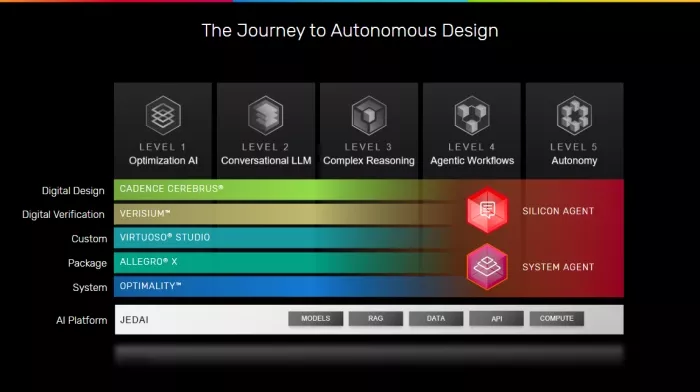Cadence Agentic AI Reduces SoC/System Engineering Time by Months
The modern design landscape is evolving rapidly, driven by shrinking design cycles, growing complexity, and limited resources. Engineers now rely on AI to tackle these challenges, marking a significant inflection point in chip design. According to TECHnalysis Research, over 50% of advanced silicon designs (using 28nm process technologies or smaller) are created with AI-assisted design. These agentic AI tools cut SoC and system engineering time by months, enabling faster, more efficient workflows and pushing the limits of what's possible in chip development, verification, and analysis.

This shift toward AI-driven design is reshaping the industry, and Cadence is at the forefront of this transformation. Drawing on its 40-year history in design, Cadence is presenting a vision for integrating agentic AI into semiconductor and system design at CadenceLIVE Silicon Valley 2025. It spans multiple domains, including digital design, debug and verification, custom/mixed-signal design, PCB, and system design. The goal is to create the best product, featuring higher performance, lower power consumption, and a smaller size (PPA), while achieving the fastest time to market through improved engineering productivity and quicker results.
Adopting Agentic AI into Semiconductor and System Design

The path to autonomous design is built on five progressive levels of AI:
Level 1. Optimization AI
The foundational layer inserts AI into verification and design processes, optimizing performance, area, cost, and schedule, while providing reinforcement learning and model prediction training. Engineers see immediate increases in throughput while maintaining accuracy.
Level 2. Conversational LLM
Introducing large language models (LLMs) into the workflow enables text-based queries and interactions, as well as runtime collateral generation, such as tool scripts, configurations, and code utilities. AI Assistants answer users' questions and create content, dramatically lowering the barrier for new users and making engineers more productive and creative.
Level 3. Complex Reasoning
This level enables AI agents to solve more complex tasks that require reasoning and chain-of-thought, such as planning, executing, and evaluating.
Level 4. Agentic Workflows
AI agents are connected to build agentic design workflows that can solve complex optimization problems across multiple tools.
Level 5. Autonomy
Ultimately, the goal is to enable a single designer to build an entire SoC by generating all the collateral and then using optimization AI to build the design solution and iterate. All this can happen automatically with minimal design intervention, by leveraging agentic AI.
Cadence.AI: Transforming Chip Design with Agentic AI Workflows Across Industries
Cadence products incorporate agentic AI into our tools to optimize throughput and accuracy. They utilize LLMs and retrieval augmented generation (RAG) technology to facilitate text-based queries and prompt engineering throughout the workflow. Additionally, Cadence tools feature a Silicon Agent framework that leverages the agentic workflows and AI platforms for creating IP and SoC design from high-level specification to detailed implementation to cope with the fast-emerging design complexity and the aggressive design PPA goals.
The impact of agentic AI extends across industries that rely on cutting-edge design innovation, including data centers, high-performance computing (HPC), automotive, aerospace and defense, and robotics.
We're applying agentic AI across our five key AI platforms that make up Cadence.AI:
- Verisium Platform – Agentic AI-driven verification optimizing and automating all phases of verification, including test planning, testbench generation, engine performance, debug, and total verification throughput.
- Cadence Cerebrus® AI Studio – A state-of-the-art SoC agentic AI-design implementation tool that can help achieve ambitious PPA goals and reduce turnaround time (TAT) for highly sophisticated chips.
- Virtuoso Studio – Agentic AI-driven custom and analog IC design with support for systems, including RF, mixed-signal, photonics, and advanced heterogeneous designs, maximizing productivity and interoperability.
- Allegro X AI – Agentic AI-driven workflow transforms PCB design by reducing placement and routing tasks, improving quality, and allowing more room for iteration and exploration.
- Optimality Intelligent System Explorer – Agentic AI-driven multiphysics analysis and optimization, lowering design risk without sacrificing accuracy.
With agentic AI across these platforms, organizations can significantly enhance their competitive edge by combining state-of-the-art functionality with ease of use and scalability.
Paul Cunningham, senior vice president and general manager of the System Verification Group at Cadence, emphasized the company's commitment to AI innovation, stating, "As we advance into smaller process nodes and tackle the complexities of modern SoC design, AI-driven chip design is no longer a luxury but a critical necessity. Cadence's agentic AI tools empower organizations to navigate the multitude of variables, optimize resources, and significantly enhance productivity. By tackling both technical challenges and organizational hurdles, Cadence's agentic AI solutions unlock unprecedented efficiency gains, driving the entire industry forward."
Extending Productivity and Addressing Industry Needs
Cadence is tackling a key challenge in the semiconductor industry: the shortage of skilled chip designers. With growing demand for custom silicon, Cadence's new agentic AI solutions empower junior engineers to handle complex design tasks, driving innovation forward. For more experienced engineers, these tools open new possibilities, enabling the creation of more designs, supporting customized solutions, and allowing multiple projects to run in parallel. These AI-driven tools don't just enhance workflows—they deliver real results, like up to 45 – 50% performance improvements and 3 – 10X improvement in engineering hours on processors and SoCs in various nodes. Thanks to these efficiencies, customization, long desired by chip designers and their clients, is now more practical than ever.
As designs progress to smaller process nodes and chips grow increasingly complex, AI is becoming a necessity. This shift is due to the multitude of variables to explore, the variety of design and analysis tools available, and the need to incorporate heterogeneous databases. Cadence's AI tools provide the intelligence needed to streamline design, optimize resources, and accelerate productivity, ensuring the industry continues to advance rapidly. By addressing both technical pain points and organizational challenges, Cadence's agentic AI solutions create opportunities for organizations to achieve unprecedented efficiency gains in their design and development efforts.
Transforming the Designs of Tomorrow with Agentic AI
As the integration of AI continues to redefine the design and verification landscape, Cadence's agentic AI solutions represent a pivotal advancement. By uniting decades of expertise with cutting-edge AI technology, Cadence is empowering engineers and organizations to realize their most ambitious goals faster and with greater impact.
To learn more about Cadence's AI capabilities and how they can enhance your design workflows, visit Cadence AI and explore the future of intelligent design.
Related Semiconductor IP
- Ultra-Low-Power LPDDR3/LPDDR2/DDR3L Combo Subsystem
- Parameterizable compact BCH codec
- 1G BASE-T Ethernet Verification IP
- Network-on-Chip (NoC)
- Microsecond Channel (MSC/MSC-Plus) Controller
Related Blogs
- Navigating the Future of EDA: The Transformative Impact of AI and ML
- DDR5 12.8Gbps MRDIMM IP: Powering the Future of AI, HPC, and Data Centers
- GDDR7: The Ideal Memory Solution in AI Inference
- UALink™ Shakes up the Scale-up AI Compute Landscape
Latest Blogs
- What Does a GPU Have to Do With Automotive Security?
- Physical AI at the Edge: A New Chapter in Device Intelligence
- Rivian’s autonomy breakthrough built with Arm: the compute foundation for the rise of physical AI
- AV1 Image File Format Specification Gets an Upgrade with AVIF v1.2.0
- Industry’s First End-to-End eUSB2V2 Demo for Edge AI and AI PCs at CES
